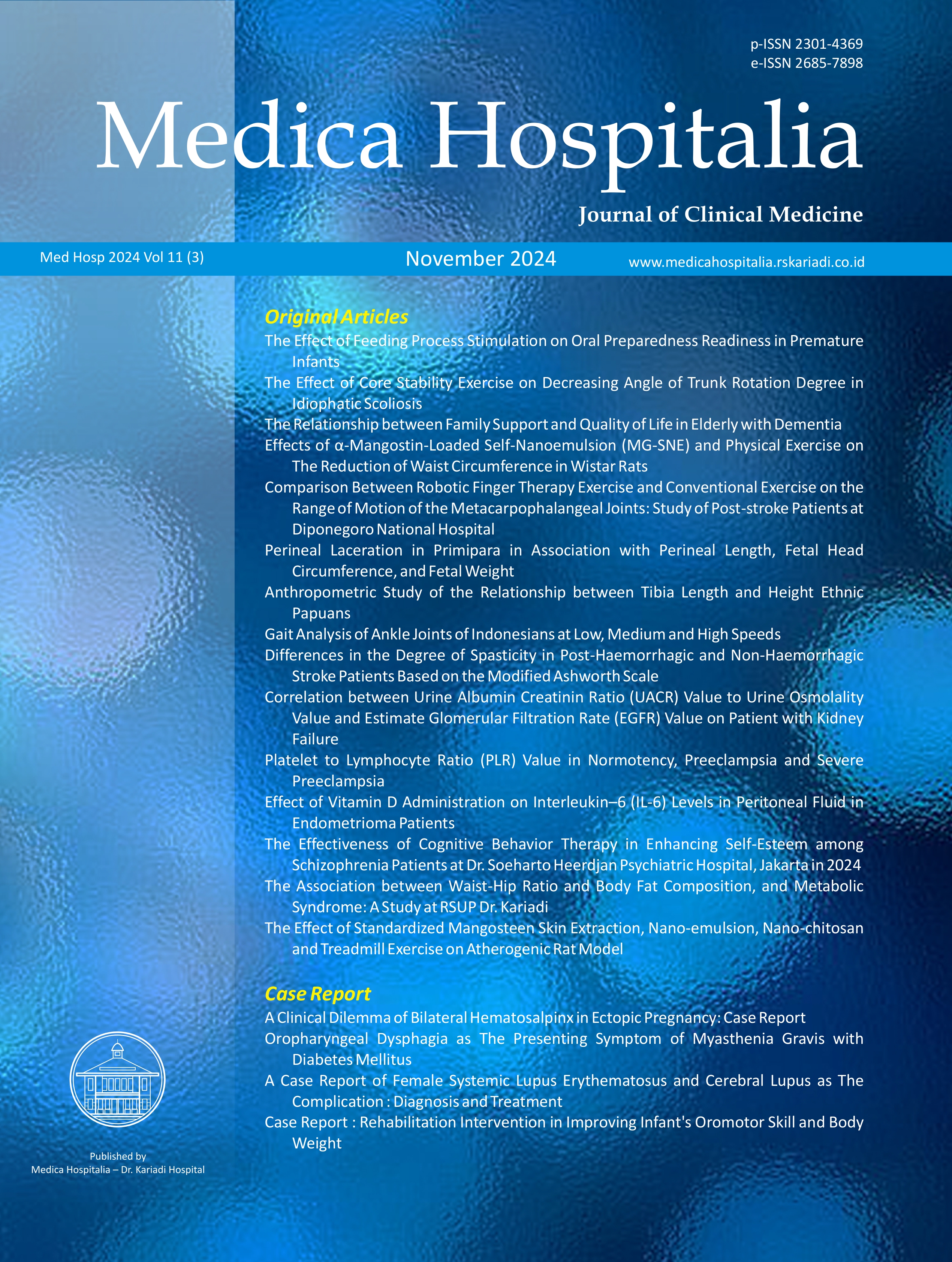Comparative Effectiveness of Betahistine vs Dimenhydrinate in Reducing Dizziness Handicap Scores in Patients with Peripheral Vestibular Disorders
DOI:
https://doi.org/10.36408/mhjcm.v12i1.1213Keywords:
Peripheral vestibular disorders, Dimenhydrinate, Betahistine, Dizziness Handicap InventoryAbstract
BACKGROUND: Peripheral vestibular disorder is a disorder of the peripheral vestibular system. Its symptoms affect the quality of life from moderate to severe. An objective assessment is quite difficult therefore a questionnaire method has been developed such as Dizziness Handicap Inventory (DHI). Aim of the treatment is to achieved optimal quality of life by using symptomatic treatment like dimenhydrinate and betahistine.
AIMS : To prove the effectiveness of betahistine and dimenhydrinate and to compare the effectiveness in reducing DHI score
METHOD : : This was an intervention study with pretest and posttest control group designs, randomized control trial, double blind study at ENT-HNS Clinic, CDC Dr. Kariadi Hospital and Dr.Soetrasno Hospital Rembang. Data was collected from September 2015 to June 2016. Subject filled out the DHI pre-test questionnaire, stratified randomly divided into 2 group. One group received betahistine 12 mg / 8 hours and the other received dimenhydrinate 50 mg / 8 hours in a double-blind selection process. After 2 weeks of drug administration, subject filled out a post test questionnaire of DHI.
RESULT : Subjects were 44 people; dimenhydrinate, 20 people (45.5%) and betahistine, 24 people (54.4%). Result showed that DHI score of post test is lower than pre test in both group with significance value of p < 0.05. There is no significant difference in DHI score of dimenhydrinate compared with betahistine group (p = 0.137).
CONCLUSION : Betahistine and dimenhydrinate are shown to be effective in lowering the DHI score.and betahistine not proven to be more effective
Downloads
References
1. Ward BK, Carey JP. Peripheral vestibuler disorders. In :Rosen CA , Gray S, Ha P, Limb C, Park S and Richter G editors. Bailey’s Head and neck surgery - otolaryngology. Sixth ed: Lippincott Williams and Wilkins; 2022. p. 3212-3230
2. Vestibular and Balance Disorders. In: Chan Y, Goddard JC. eds. K.J. Lee’s Essential Otolaryngology: Head and Neck Surgery, 12e. McGraw-Hill Education; 2019.
3. PERDOSSI PDSSI. Guidelines for managing vertigo. Pharmacological therapy of vertigo. Jakarta: PERDOSSI; 2012. p. 205-13.
4. Petruci AG, Dispenza F, Stefano AD. Epidemiology of dizziness. In: Dispenza F, Stefano AD, editors. Tetxtbook of vertigo diagnosis and management. New Delhi: Jaypee Brothers Medical Publisher; 2014. p. 26-37.
5. Neuhauser HK, Lempert T. Vertigo: epidemiological aspects. Seminars in Neurology; Berlin, Germany: Robert Koch Institute; 2009. p. 473-81.
6. Voorde MT, Loonen HJVdZ, Leeuwen RBV. Dizziness impairs health related quality of life. Qual Life Res. 2012(21):961-6.
7. Gans R. Vestubular rehabilitation therapy. In: Dispenza F, Stefano AD, editors. Textbook of vertigo diagnosis and management. New Delhi: Jaypee brothers medical publisher; 2014. p. 245-58.
8. Goto F, Tsutsumi T, Ogawa K. The Japanese version of the dizziness handicap inventory as an index of treatment sucess: exploratory factor analysis. Acta Oto Laryngologica. 2011;2011(131):817-25.
9. Mutlu B, Serbetcioglu B. Discussion of the dizziness handicap inventory. Journal of vestibular research 2013;23:271-7.
10. Yacovino DA, Hain TC. Medical management of vertigo. In: Dispenza F, Stefano AD, editors. Textbook of vertigo diagnosis and management. New Delhi: Jaypee Brothers Medical Publisher; 2014. p. 219-36.
11. Katzung BG. Histamine, serotonin and the ergot alkaloid. In: Katzung BG, Masters SB, Trevor AJ, editors. Basic and clinical pharmacology. China: The McGraw-Hill companies; 2009.
12. Zhang D, Tashiro M, Shibuya K, Okamura N, Funaki Y, Yoshikawa T, Kato M, Yanai K. Next-day residual sedative effect after nighttime administration of an over-the-counter antihistamine sleep aid, diphenhydramine, measured by positron emission tomography. J Clin Psychopharmacol. 2010 Dec;30(6):694-701. doi: 10.1097/jcp.0b013e3181fa8526. PMID: 21105284.
13. NO.092/MENKES/SK/II/2012 KMR. Highest retail prices for generic drugs in 2012. In: Health, editor. Jakarta: Ministry of Health 2012. p. 1-29.
14. Cirek Z, Schwarz M, Baumann W, Novotny M. Efficacy and tolerability of fixed combination of cinnarizine and dimenhydrinate versus betahistine in the treatment of otogenic vertigo : a double blind randomised clinical study. Clin Drug Invest. 2005;25(6):377-89.
15. Scholtz AW, Steindl R, Burchardi N, Bognar-Steinberg I, Baumann W. Comparison of the theraupetic efficacyof a fixed low dose combination of cinnarizine and dimenhydrinate with betahistine in vestibular neuritis : a randomized, double-blind, non-inferiority study. Clin Drug Invest. 2012;32(6):387-99.
16. Novotny M, Kostrica R. Fixed combination of cinnarizine and dimenhydrinate versus betahistine dimesylate in the treatment of meniere's disease: a randomized, double blind, parallel group clinical study. Int Tinnitus J. 2002;8(2):115-23.
17. Albera R, Ciufofolotti R, Cicco MD, Benedittis GD, Grazioli I, Melzi G, et al. Double blind, randomized multicenter study comparing the effect of betahistine and flunarizine on the dizziness handicap in patients with recurrent vestibular vertigo. Acta Otolaryngol. 2003;123:588-93.
18. Mira E, Guidetti G, Ghilardi PL, Fattori B, Malaninno N, Maiolino L. Betahistine dihydrochloride in the treatment of the peripheral vestibular vertigo. Eur Arch Otorhinolaryngol. 2003;260:73-7.
19. Lai Y-T, wang T-C, Chuang L-J, Chen M-H, Wang P-C. Epidemiology of vertigo-a nastional survey. Otolaryngol Head and Neck Surg. 2011;145:110-6.
20. Bajenaru O, Roceanu AM, Albu S, Zainea V, Pascu A, Gabriela M, et al. Effects and tolerability of betahistine in patients with vestibular vertigo : results from the romanian contigent of the OSVaLD study. International Journal of General Medicine. 2014;7:531-8.
21. Martines F, Agrifoglio M, Bentivegna D, Mucia M, Salvago P, Sireci F, et al. Treatment of tinnitus and dizziness associated vertebrobasilar inssuffiency with a fixed combination of cinnarizine and dimenhydrinate. Acta Medica Mediterranea. 2012;28:291-6.
22. Kiroglu MM, Dagkiran M, Ozdemir S, Surmelioglu O, Tarkan O. The effects of betahistine and dimenhydrinate on caloric test parameters; slow phase velocity of nystagmus. The journal of international advanced otology. 2014;10(1):68-71.
Additional Files
Published
How to Cite
Issue
Section
Citation Check
License
Copyright (c) 2025 Christin Rony Nayoan, Christin Rony Nayoan, Muyassaroh Muyassaroh, Zulfikar Naftali (Author)

This work is licensed under a Creative Commons Attribution-ShareAlike 4.0 International License.
Copyrights Notice
Copyrights:
Researchers publishing manuscrips at Medica Hospitalis: Journal of Clinical Medicine agree with regulations as follow:
Copyrights of each article belong to researchers, and it is likewise the patent rights
Researchers admit that Medica Hospitalia: Journal of Clinical Medicine has the right of first publication
Researchers may submit manuscripts separately, manage non exclusive distribution of published manuscripts into other versions (such as: being sent to researchers’ institutional repository, publication in the books, etc), admitting that manuscripts have been firstly published at Medica Hospitalia: Journal of Clinical Medicine
License:
Medica Hospitalia: Journal of Clinical Medicine is disseminated based on provisions of Creative Common Attribution-Share Alike 4.0 Internasional It allows individuals to duplicate and disseminate manuscripts in any formats, to alter, compose and make derivatives of manuscripts for any purpose. You are not allowed to use manuscripts for commercial purposes. You should properly acknowledge, reference links, and state that alterations have been made. You can do so in proper ways, but it does not hint that the licensors support you or your usage.
























